







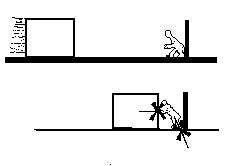 The one constant around the world is the action of gravity upon each and every structure that is erected. The primary function of all structural design is to make a building stand-up. Understanding architectonics will enable a designer to include these issues as part of a design language that will create a significantly clearer architectural expression. Primary to this study is the concept of a force. A force is actually very abstract. It can be defined, but it cannot become physically apparent until it meets resistance. Imagine a six foot tall block of ice sliding along a frictionless surface laid inside of a hockey rink. If a person props herself against the wall and tries to stop the ice, she will perceive the force imparted by the block of ice. She transfers the force of the block of ice into a force that moves through her body into the ground. The ground resists her with a force of varying magnitude to match her as she exerts an increasing resistance force to stop the block of ice. If all of these forces are transferred successfully, then the slide is arrested without a strength or stability failure. However, if any one of the pieces of this fragile structural system fail......
The one constant around the world is the action of gravity upon each and every structure that is erected. The primary function of all structural design is to make a building stand-up. Understanding architectonics will enable a designer to include these issues as part of a design language that will create a significantly clearer architectural expression. Primary to this study is the concept of a force. A force is actually very abstract. It can be defined, but it cannot become physically apparent until it meets resistance. Imagine a six foot tall block of ice sliding along a frictionless surface laid inside of a hockey rink. If a person props herself against the wall and tries to stop the ice, she will perceive the force imparted by the block of ice. She transfers the force of the block of ice into a force that moves through her body into the ground. The ground resists her with a force of varying magnitude to match her as she exerts an increasing resistance force to stop the block of ice. If all of these forces are transferred successfully, then the slide is arrested without a strength or stability failure. However, if any one of the pieces of this fragile structural system fail......
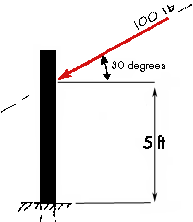 A "force" is an action that changes, or tends to change, the state of motion of the body upon which it acts. It is a vector quantity that can can be represented either mathematically or graphically.
A "force" is an action that changes, or tends to change, the state of motion of the body upon which it acts. It is a vector quantity that can can be represented either mathematically or graphically.
A complete description of a force MUST include its:
The Direction of a force is discerned by oberserving the line of action of the vector of the force. The Sense refers to the direction of the movement of the vector along that line of action. The sense is always represented on the vector by an arrowhead. These two attributes can be either a written verbal description (i.e. down and to the right, up and to the left, slightly up and to the right ) or more conveniently expressed in terms of 360 degrees (i.e. 112 degrees, 273 degrees, 87.5 degrees). In the later case, one begins with zero and increases clock-wise with the direction of the arrowhead until 360 is reached. The sense of the force can also be expressed as a positive or negative sign. This is especially useful when combining forces algebraically. It is very important not to confuse the direction and sense. The direction always relates to the line of action of the vector, and the sense is the way in which the vector would move along that line. In the example, the direction and sense of the 100 lb force would be "down and to the left" or "240 degrees."
The Point of Application is often overlooked in the description of a force. However, it is fully as important as the magnitude of the force! It is the exact location of the application of a force on a body. It can either be a relative measurement or a set of coordinates. This location is critical to the successful resolution of multiple forces acting on a body.
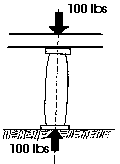 A 100 pound force is applied to the stone column in the diagram. The colum will experience this force at every point along the line of action of the force. As a matter of fact, the force will also be transferred to the ground which is supporting the column. Thus, the earth below the column along the line of action of the force will also experience the 100 kip load. This illustrates the Principle of Transmissibility. The point of application of an external force acting on a body (structure) may be transmitted anywhere along the force's line of action without affecting the other external forces (reactions and loads) acting on that body. This means that there is NO NET CHANGE in the static effect upon any body if the body is in equilibrium. This can be further illustrated with the following diagram.
A 100 pound force is applied to the stone column in the diagram. The colum will experience this force at every point along the line of action of the force. As a matter of fact, the force will also be transferred to the ground which is supporting the column. Thus, the earth below the column along the line of action of the force will also experience the 100 kip load. This illustrates the Principle of Transmissibility. The point of application of an external force acting on a body (structure) may be transmitted anywhere along the force's line of action without affecting the other external forces (reactions and loads) acting on that body. This means that there is NO NET CHANGE in the static effect upon any body if the body is in equilibrium. This can be further illustrated with the following diagram.
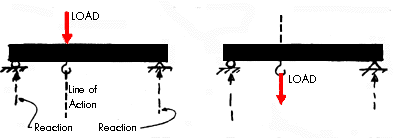
Assume that a beam is supported at its ends. A load is applied to the top of the beam that is acting downward. This load could be a person standing on the beam. The load creates reactions that push up at the two points of support. The line of action of the load (person) on the beam also passes through a hook that is attached to the underside of the beam. Now, if the person standing on top of the beam would climb down and hold on to the hook exactly below the point where they were previously located so that the lines of action were exactly the same, the reactions at the ends of the beams would not change. This is because the load of the person is still acting along the same line of action. As long as a load is applied at any point along the line of action the external reactions will not change.
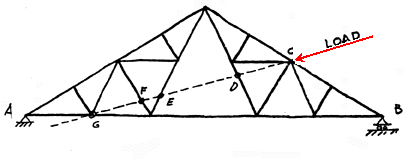
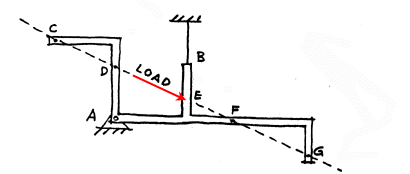
This strangly shaped beam is another example of a structure that is loaded at a specific point, namely E. In order for the structure to remain at rest there must be reactions of some kind at points A and B. The reaction at B is a tension reaction since it is a cable. Again, if the load was applied at points C, D, E, F or G on this rigid body (structure) the reactions at A and at B would remain exactly the same.
ONLY the EXTERNAL forces (reactions) remain unchanged. Some of the internal resisting forces within the elements of the structure change as the load is applied at different points along its line of action. This illustrates one important difference between INTERNAL and EXTERNAL forces.
The Principle of Transmissibility applies to any body (blobs, balloons, simple beams, crooked beams, trusses, shells, etc.). It is independent of the body's size or shape.